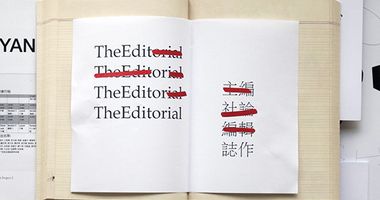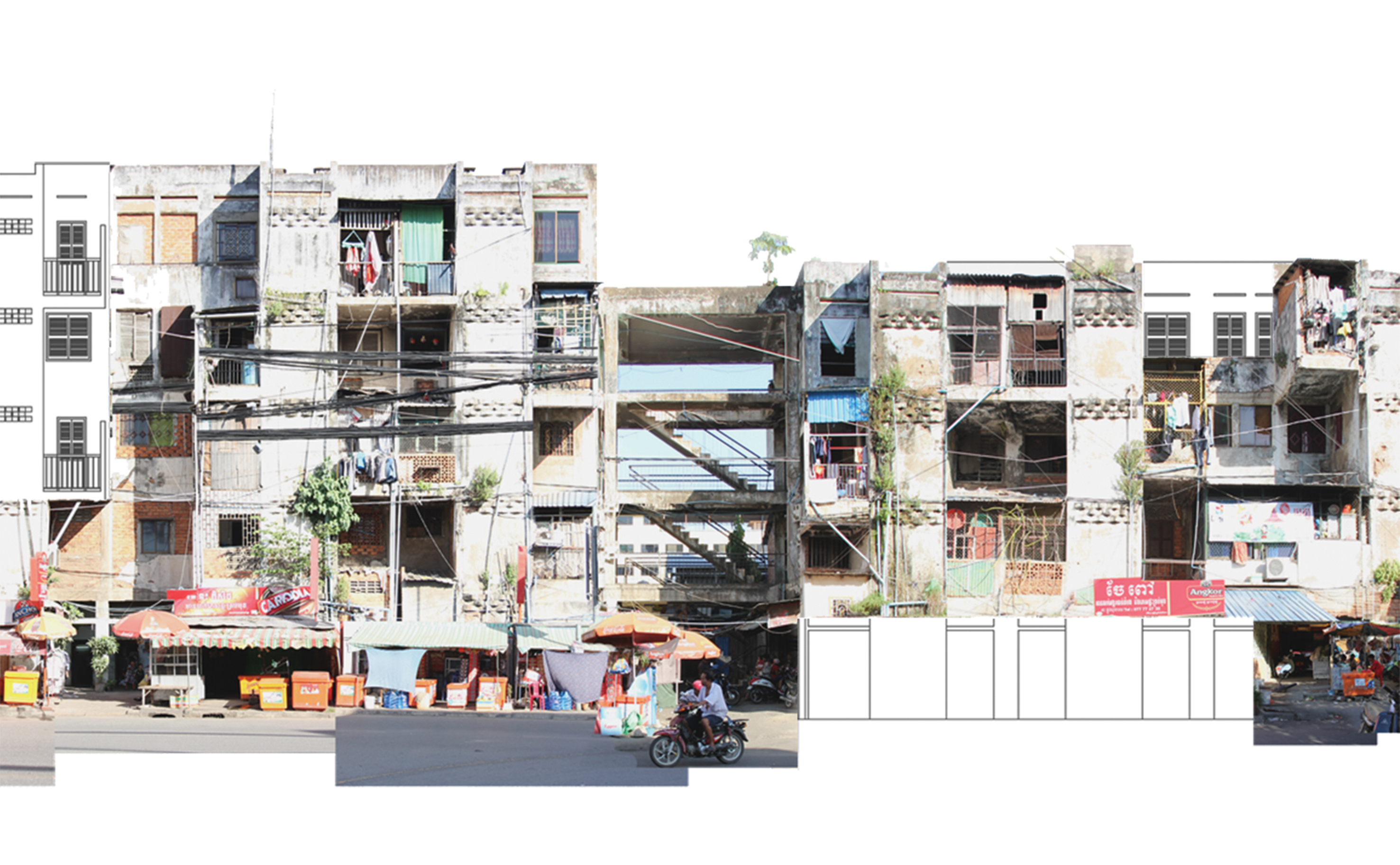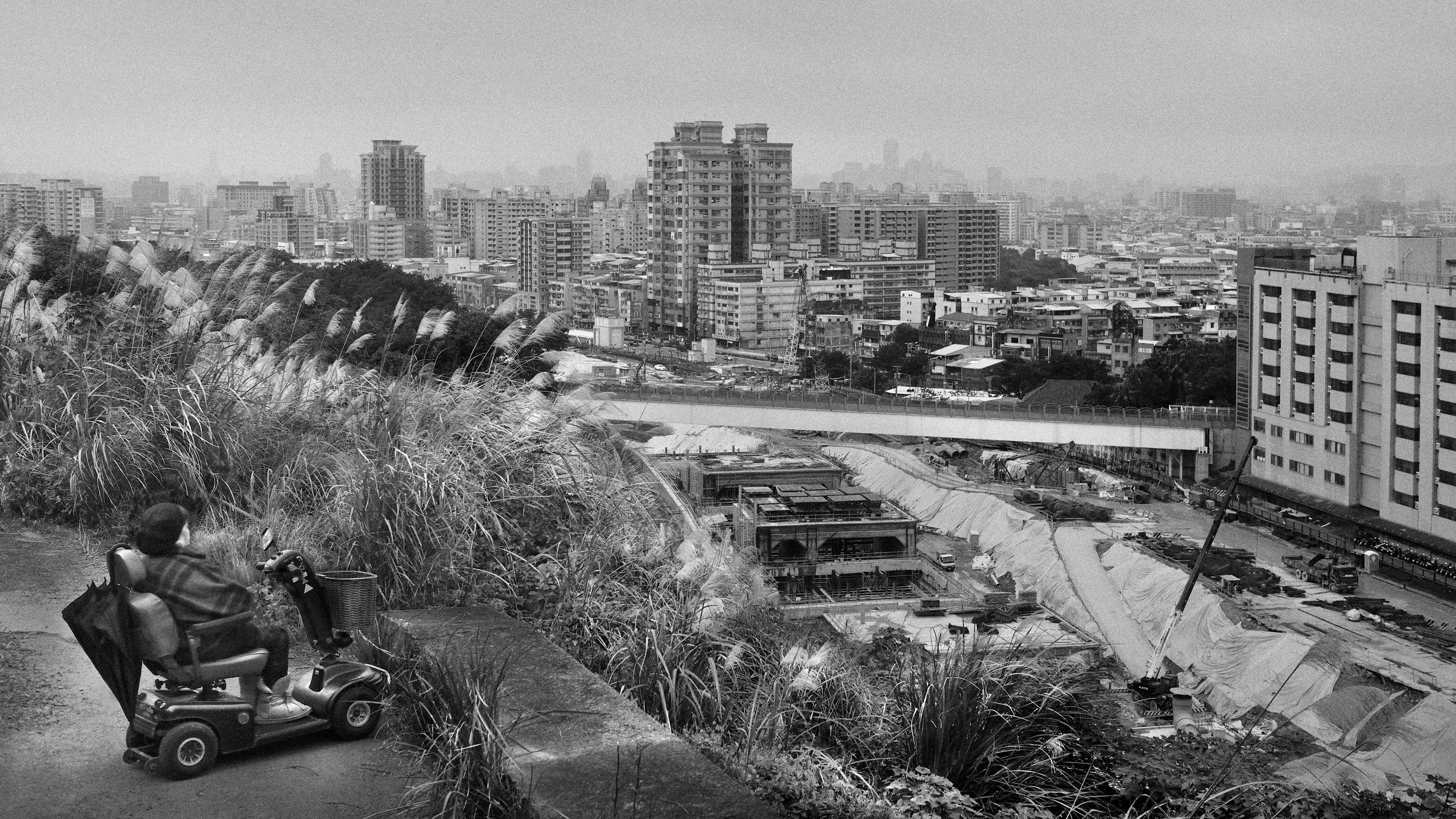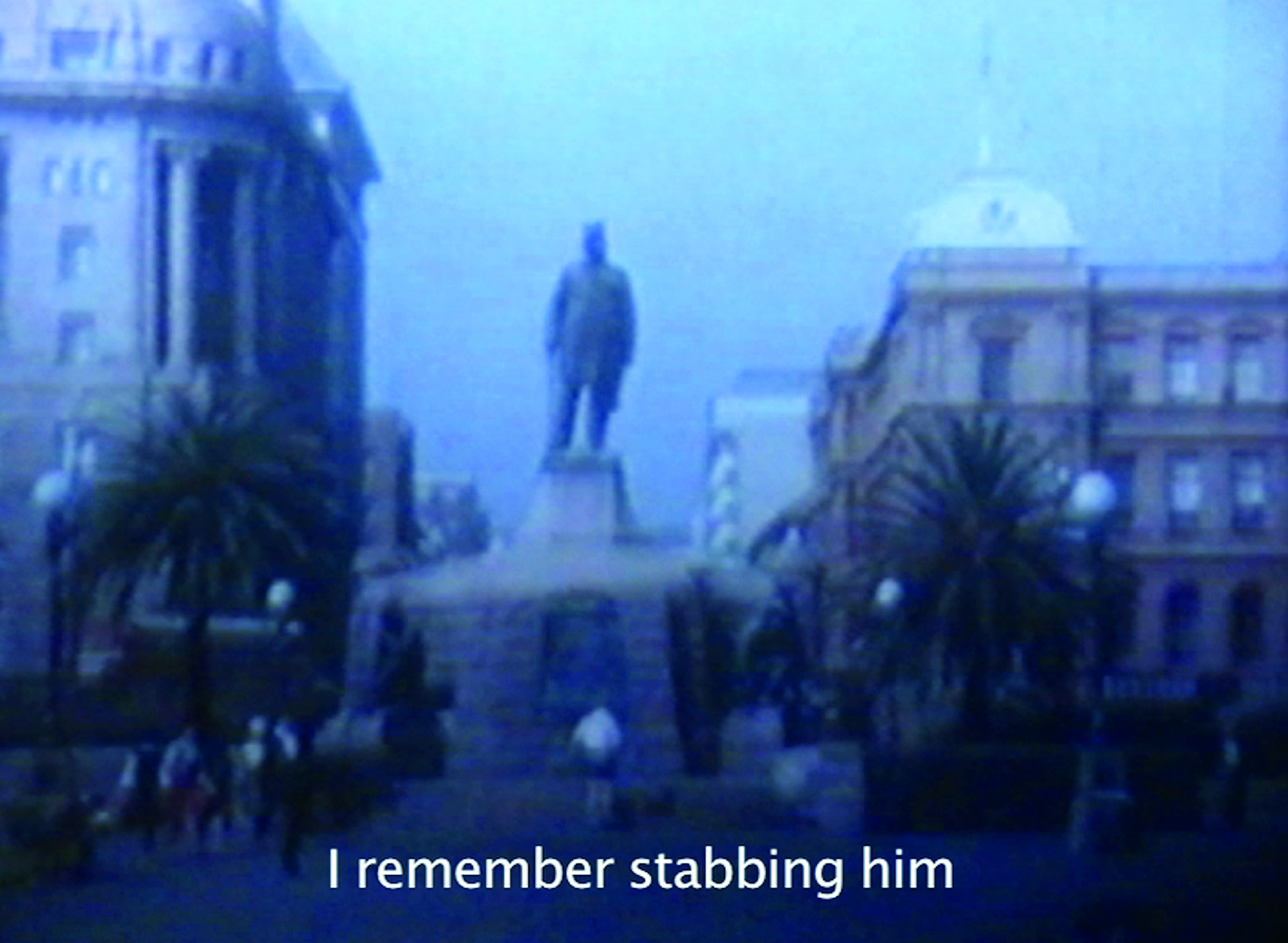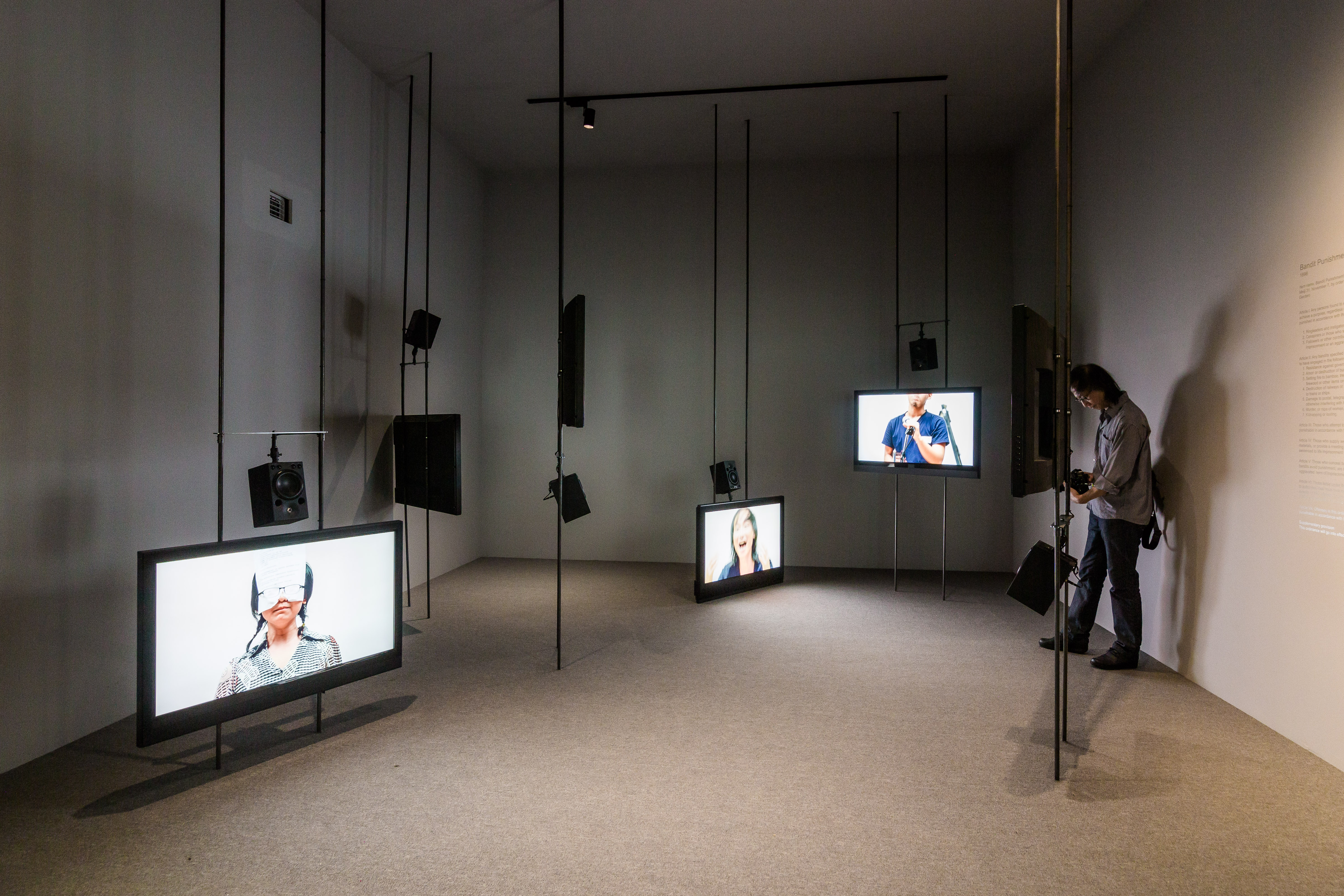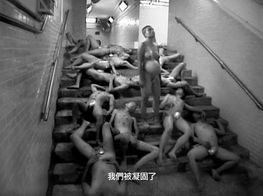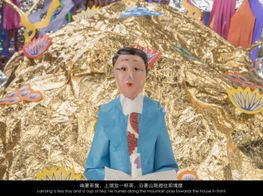The 2016 Taipei Biennial: 'Gestures and Archives of the Present, Genealogies of the Future: A New Lexicon for the Biennial'
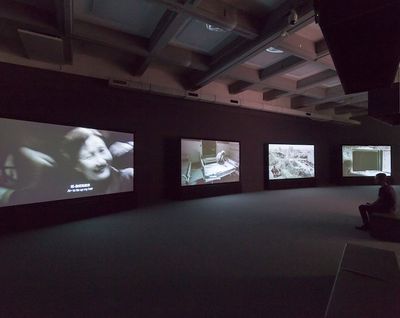
Installation view, Chen Chieh-Jen, Real of Reverberations (2014). © Taipei Fine Arts Museum.
Curated by Corinne Diserens—renowned French curator and former director of the École de Recherche Graphique in Brussels—and housed at the Taipei Fine Arts Museum, the tenth Taipei Biennial Gestures and Archives of the Present, Genealogies of the Future: A New Lexicon for the Biennial (10 September 2016–5 February 2017) casts a wide net to provoke deeper reflections on the politics of historiography and hierarchies of narrative formation. Around 80 artists participated in the exhibition, which aims to examine the role artists play in questioning the power involved in the preservation (or exclusion) of public archives.
The exhibition is framed around three main areas of inquiry—performing the archive; performing the architecture; and performing the retrospective—and considers how knowledge production is never conclusive, but always a point of re-activation.
These intentions are explored by an ongoing programme of events running until February, made up of symposiums, live performances, a robust cinema programme, and an editorial platform initiated by Ingrid Chu of Asia Art Archive and Kit Hammonds of Vernacular Institute.
Staged over the two floors of the Taipei Fine Arts Museum, Diserens subtly transforms the museum's white cube status by muting its walls to subdued monochromatic tones and unimposing architectural partitions. On entering the ground floor space, piles of the magazine 39 Strike Objects presented by Jean-Luc Moulène (2016)—a project first initiated by Moulène in 1999 but presented in magazine-form specifically for the Biennial—are placed on stacks of cardboard boxes for audiences to take away.
Inside the pages are photographs of various objects—made between the 1970s and 1990s—which document the history of trade union activism and workers' protests in France. These include the Novacore suit (the image that appears on the biennale's promotional material), one of four pinstripe suits produced by technically skilled workers to resist the marketisation of the textile industry. Collectively these object(s), as art historian Paulo Magagnoli has argued, 'stand for the workers' appropriation of the means of production'.
Through not an installation piece per se, Moulène's gesture points to a socialist impulse that runs throughout the exhibition, in which the artist—like the worker on strike—produces artefacts that question hegemonic power. By reinstating the political at the heart of the artistic inquiry, the Biennial becomes a repository for producing a counter-archive within the institutional space that enables reflection on how politics operates beyond the level of state networks.
One display in the ground floor gallery, for instance, is an extensive, ethnographic mixed-media project by Cambodian urbanist and architect Pen Sereypagna, who along with The Vann Molyvann Project—a collective architect-led research project initiated in 2009 by Canadian architect Bill Greaves and managed by Sereypagna—charts the corrosive effects of Cambodian gentrification on public space. On one side of the partitioned wall layered photographic images, titled Genealogies of Bassac – White Building West Elevation (2014), details the evolutionary process of (de)development occurring in the Bassac neighbourhood in Phnom Penh.
On the other side, dense visual ephemera is on display, including small-scale architectural models, textual information, photographs, and a documentary film, all of which present the postcolonial architectural style championed by Vann Molyvann (known as New Khmer Architecture) that is now under threat by urban transformations and ruptures brought on by privatisation. Presented like an architectural firm's display, the painstaking archival research critically considers infrastructure building, and specifically the sanitising effects of urban developments on social groups; it is a theme that is extended throughout the exhibition.
Architecture's role in social exclusion and oppression is pronounced to greater aesthetic effect in Chen Chieh-jen's masterful video installation Realm of Reverberations (2014). The work tells of Taipei's Losheng Sanatorium,a residential complex built during the Japanese colonial period to house individuals suffering from Hansen's disease (more commonly known as leprosy). The four-channel wall-sized screens—monumental in scale—accentuate the pervasive effects of segregating and reordering society through a process of exclusion and elimination of what is deemed 'disorder'.
The work explores neocolonial forms of (invisible) bureaucratic control, inscribed with the legacies of Japanese colonialism, US imperialist interventions, and ongoing Taiwanese development projects in which resistance movements are labeled 'Dissenting Voices of the Unwashed, Disobedients, Non-Citizens and Exiles in Their Own Home'. Here, the politics of control are challenged, to consider the (in/visible) role bureaucracy and urbanisation have played in maintaining a system of inequality and oppression.
In all, the tenth Taipei Biennial seeks to decolonise processes of narrative construction by highlighting ruptures brought on by violent colonial histories. But rather than focusing on shocking imagery, the majority of works seek to expose hidden violations and histories overlooked by institutional and state politics. For example, Penny Siopis' film Obscure White Messenger (2010), shown as part of the symposium programme, considers key moments in South Africa's history occluded from collective memory that fit neither the state nor the ANC's liberation discourse.
The film interrogates colonialism's violent legacy and the failures of the apartheid South African state bureaucracy. It retells the assassination of the 'Architect of Apartheid', Prime Minister H.F. Verwoerd at the hands of parliamentary messenger, Dimitri Tsafendas, who was given the job because he was able to pass as white.
Taking its title from Nelson Mandela's 1995 autobiography, Long Walk to Freedom—in which Tsafendas is dismissed as the obscure white messenger (pointing to his peripheral status in South Africa's history)—the film's emphasis leans less towards determining whether the murder was a politically motivated act or the result of psychosis, and instead considers how and why some history-altering events remain mere footnotes within a nation's collective memory. Through haunting repetitive motifs of found footage (scenic images are meant to represent the various locales in which Tsafendas grew up) and subtitled text (the transcript of the psychiatrist's interview with Tsafendas after he committed the murder), Siopis seeks to disrupt documentary representations that tend to posit biographical details as truth. Under attack is the narrowing of politicised narratives that fail to capture the complexities of lived experiences.
The erasure of ethnographic details and its subsequent effect on narrative formations is also questioned in Santu Mofokeng's photography series, The Black Photo Album / Look at Me: 1890 – 1950 (1997). As images of black South African families flash on a standalone projector screen, Mofokeng interrupts the photographs with text that posits questions around the politics of spectatorship. In asking, 'Are these images evidence of mental colonisation or did they serve to challenge prevailing images of 'The African' in the western world?' he provokes the viewer to consider privileges and and power inequalities imbedded in historical narratives, specifically how the racialised body is always mediated through the white coloniser.
Similarly, Ângela Ferreria's multimedia installation A Tendency to Forget (2016) considers the colonial complicity rooted in academic disciplines (notably anthropology) in shaping and propagating the politics of 'otherness'. Together, these works—which are placed in close proximity to one another in the gallery space—seek to deconstruct the systems of power rooted in non-European contexts and to expose the methodologies (shaped by racial and political biases) of constructing knowledge.
The historical sobriety and critical intensity articulated on the ground floor is somewhat diluted in the first-floor exhibition space. At the gallery's entrance, Sven Augustijnen's Summer Thoughts (2012–16)—a series of large wall-mounted personal letters written by the artist to curator Marta Kuzma—bridges discussions on cultural destruction under European fascism with the ongoing political turmoil in the Middle East.
Newspaper clippings, photographs and literature referenced in the letters are placed in a vitrine underneath the main display, and to the right a small screen showing images of Hannah Ryggen's tapestries flash on an (easily missable) small-screen. Whilst the inclusion of personal letters as worthy historical documents points to a democratisation of aesthetic form foregrounded throughout the exhibition, the artist's remove from the political violence he muses on—during his travels to Europe and New York—reads as a flippant exercise in intellectual pedantry, calling into question his positionality (read: European privilege) and its impact on knowledge production.
My intention here is not to reduce a consideration of this exhibition to a discussion on identity politics; after all, the exhibition successfully articulates the importance of a trans-historical and trans-cultural knowledge for producing and performing the archive. Yet lacking in Augustijnen's piece is a nuanced engagement with historical and cultural resonances and how they speak to wider socio-political contexts, which is elsewhere articulated to better effect.
For example, Taiwanese artist Hong-Kai Wang's multichannel video installation The Band of the Awful Ones (2016)—produced during workshops at Taipei's Guling Street Avant-Garde Theatre—seemingly takes its cue from Paulo Freire's Pedagogy of the Oppressed. By deploying theatrical practices to interrogate the 'Bandit Punishment Ordinance'—a 1898 Taiwanese legal text that disavows any forms of violent resistance against the government or the military that was enforced during the Japanese colonial era—the workshop participants embody the lost narratives and voices of those made punishable by oppressive laws.
Likewise, theatrical satire informs Taiwanese artist Su Yu-Hsien video installation, Prophet (2016)—a restaging of an play written by Taiwanese avant-garde artist Huang Hua-Chen during Taiwan's post-war period—in which a married couple bickers in an empty theatre. The absences on the stage (limited to off-screen sounds and light flickers) and the ensuing dialogue which centres on the existential reflections of the male protagonist, are philosophical and absurd in equal measure: the husband's 'mad-prophet' speech offers a tragicomic reflection on the banalities of everyday life vis-à-vis his delusions of self-grandeur (he is a low-paid copyist who believes he played a central role in China's May Fourth Movement—claims which are quickly dismissed by his wife). Here, the dialectic between desire and failure is pronounced, offering a more general critique of delusions of grandeur accelerated by late-capitalism's insistence on individualism.
Elsewhere, the pervasive effects of 'flawed fictional narratives' that shape our cultural logic—be it dominant ideologies of capitalism or otherwise—is probed in Shubigi Rao's parodic ink sketch series Useful Fictions (2013). Rao reveals how imbalances of power are constituted and justified through the use of falsifying vocabularies and linguistic subversions that ensure political abuses, oppressions, inequalities and hypocrisy persist. In one sketch, an image of books burnt at the hands of Fascist dictators become 'sprinklings of confetti on a fascist parade', inviting us to contemplate the trauma of cultural destruction and its dismissal by the powerful; in another, colonialism is reduced to a three-pronged mandate that translates genocide and violence into a necessary design.
By destabilising the sacred category of historical truth to expose the myth-making of master narratives and insidiousness of political tropes, Rao seeks to un-muzzle history from the grips of censorship, revealing the powerful role that artists play in disrupting knowledge hierarchies. Here, as with the exhibition at large, historical narratives are revealed to be more than simply—as Hayden White has elsewhere observed—a 'neutral discursive form'.
Of course, the exhibition as an organising structure is always an insistence of power, insofar as it partakes in processes of inclusion and exclusion. Yet within the limitations of the Biennial's institutional space, Diserens does a commendable job of considering the multiple genealogies and political resonances of cross-regional histories in order to activate a critical space that allows us to reconsider our own regionalism and cultural contexts while avoiding political didacticism. (The inclusion of predominantly Taiwanese artists—in total over 30 artists from Taiwan will be represented throughout the Biennial programme—is particularly significant). Likewise, the Biennial does not pose self-reflexive questions on what contemporary art is or isn't, but rather centralises the artists' role in reflecting on the contemporary moment.
Refreshingly, this is an exhibition that is not driven by the sensation of spectacle, or the commercial populism that accompanies the 'eventicisation' of the biennial model. Rather, works pay heed to the (slow) process of knowledge production, in which critical reflexivity is favoured over sloganistic, click-bait politics. Intellectual rigour is prioritised so that an analytical and heterogeneous space might re-catalyse our thinking around archival process, in which the past is used to reconsider and reconfigure processes of knowledge production in the present. —[O]

